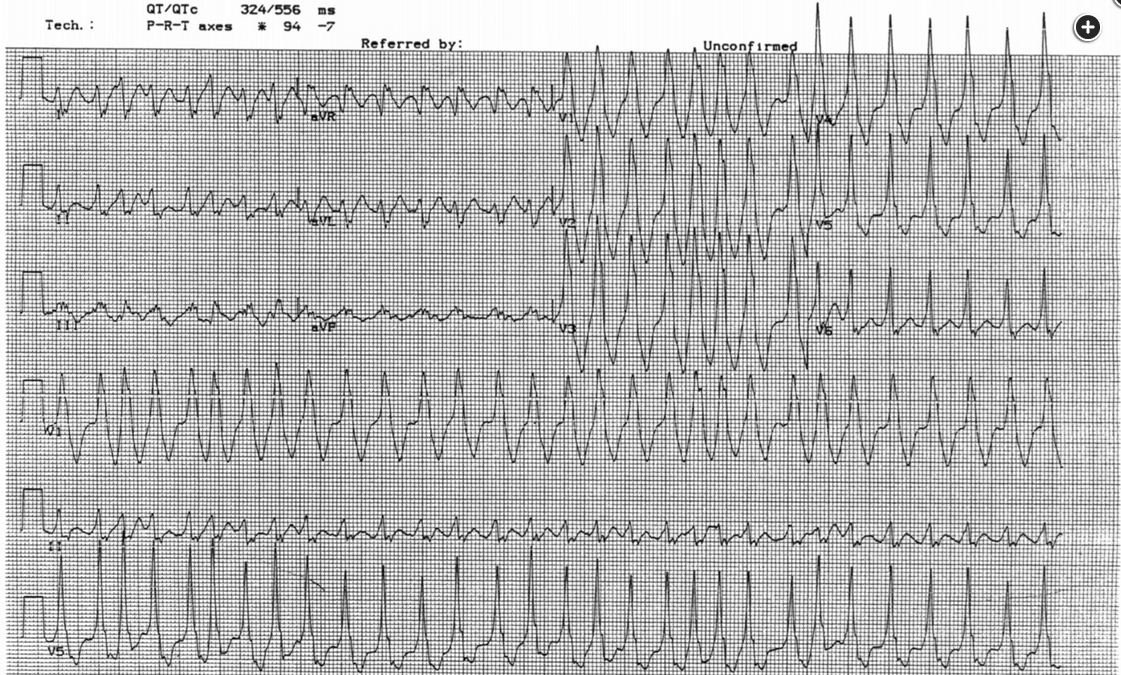think WPW in afib with wide QRS
- related: cardiac arrythmia
- tags: #literature #icu #cardiology

The rhythm is atrial fibrillation—it is irregularly irregular without discernible P waves. Some of the intervals are very short—the interval between the second and third beat is about 220 milliseconds; if sustained, this would correspond to a heart rate of 273/min. The QRS complex is wide in some beats, narrower in others, and in fact, differs from beat to beat. This combination of features makes the diagnosis of Wolff-Parkinson-White (WPW) syndrome with atrial fibrillation.
Although, classically, WPW is diagnosed by the presence of a short PR interval and a delta wave in sinus rhythm, it is important to be able to make the diagnosis of WPW with atrial fibrillation when presented with an ECG such as this one. The reason is that WPW is characterized by the presence of dual pathways, one conducting through the atrioventricular (AV) node and the other a bypass tract that inserts directly into the His-Purkinje system and bypasses the AV node. In atrial fibrillation, the ventricular rate is determined by competition between impulses that go through the AV node and those that go down the bypass tract; the AV node has limited conduction (that is, type 1 [Wenckebach] second-degree AV block is a normal response to atrial rates that are fast enough in order to protect the ventricles), but the bypass tract does not. As such, in WPW with atrial fibrillation, drugs that slow AV nodal conduction increase the number of impulses that go down through the bypass tract and actually increase ventricular rate in this setting. Only drugs that slow conduction down the bypass tract are indicated.
Procainamide slows conduction down bypass tracts in WPW. Although some of the complexes are wide, this is not ventricular tachycardia, which can be slightly irregular but not to this extent, and which would have the same QRS width with every beat.
Lidocaine is effective only in ventricular tachycardia.
Adenosine causes AV nodal blockade and so, as above, would increase the ventricular rate in this setting. Although that increase would likely be transient, there have been case reports of adenosine precipitating ventricular fibrillation in WPW with atrial fibrillation.
Esmolol also causes AV nodal blockade.1234
Links to this note
Footnotes
-
Osmancik PP, Stros P, Herman D. In-hospital arrhythmias in patients with acute myocardial infarction - the relation to the reperfusion strategy and their prognostic impact. Acute Card Care. 2008;10(1):15-25. PubMed ↩
-
Redfearn DP, Krahn AD, Skanes AC, et al. Use of medications in Wolff-Parkinson-White syndrome. Expert Opin Pharmacother. 2005;6(6):955-963. PubMed ↩
-
Wolff L, Parkinson J, White PD. Bundle-branch block with short P-R interval in healthy young people prone to paroxysmal tachycardia. 1930. Ann Noninvasive Electrocardiol. 2006;11(4):340-353. PubMed ↩